CHEVROLET KODIAK 2006 User Guide
Manufacturer: CHEVROLET, Model Year: 2006, Model line: KODIAK, Model: CHEVROLET KODIAK 2006Pages: 398, PDF Size: 5.72 MB
Page 11 of 398
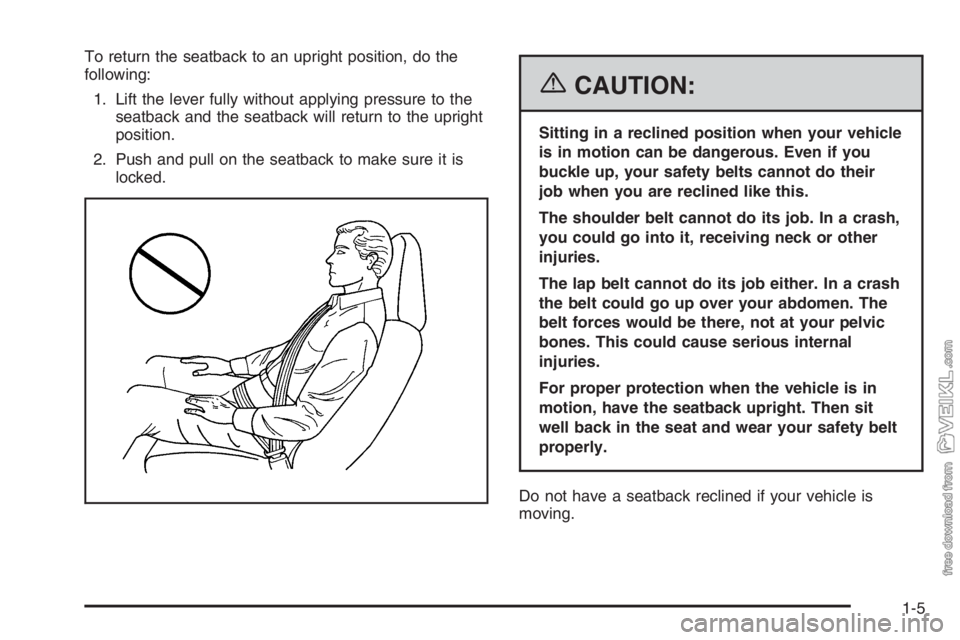
To return the seatback to an upright position, do the
following:
1. Lift the lever fully without applying pressure to the
seatback and the seatback will return to the upright
position.
2. Push and pull on the seatback to make sure it is
locked.
{CAUTION:
Sitting in a reclined position when your vehicle
is in motion can be dangerous. Even if you
buckle up, your safety belts cannot do their
job when you are reclined like this.
The shoulder belt cannot do its job. In a crash,
you could go into it, receiving neck or other
injuries.
The lap belt cannot do its job either. In a crash
the belt could go up over your abdomen. The
belt forces would be there, not at your pelvic
bones. This could cause serious internal
injuries.
For proper protection when the vehicle is in
motion, have the seatback upright. Then sit
well back in the seat and wear your safety belt
properly.
Do not have a seatback reclined if your vehicle is
moving.
1-5
Page 12 of 398
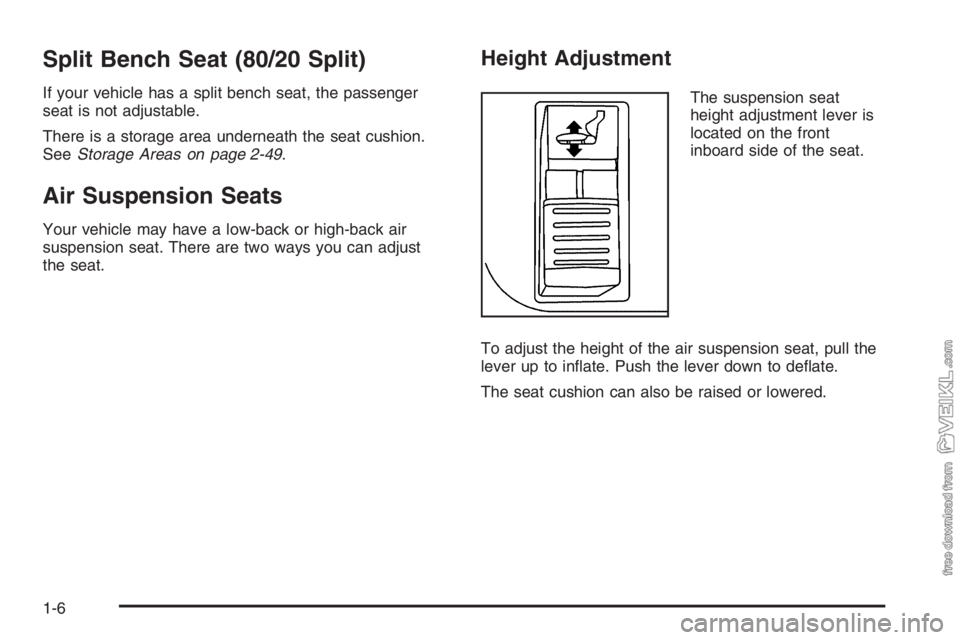
Split Bench Seat (80/20 Split)
If your vehicle has a split bench seat, the passenger
seat is not adjustable.
There is a storage area underneath the seat cushion.
SeeStorage Areas on page 2-49.
Air Suspension Seats
Your vehicle may have a low-back or high-back air
suspension seat. There are two ways you can adjust
the seat.
Height Adjustment
The suspension seat
height adjustment lever is
located on the front
inboard side of the seat.
To adjust the height of the air suspension seat, pull the
lever up to inflate. Push the lever down to deflate.
The seat cushion can also be raised or lowered.
1-6
Page 13 of 398
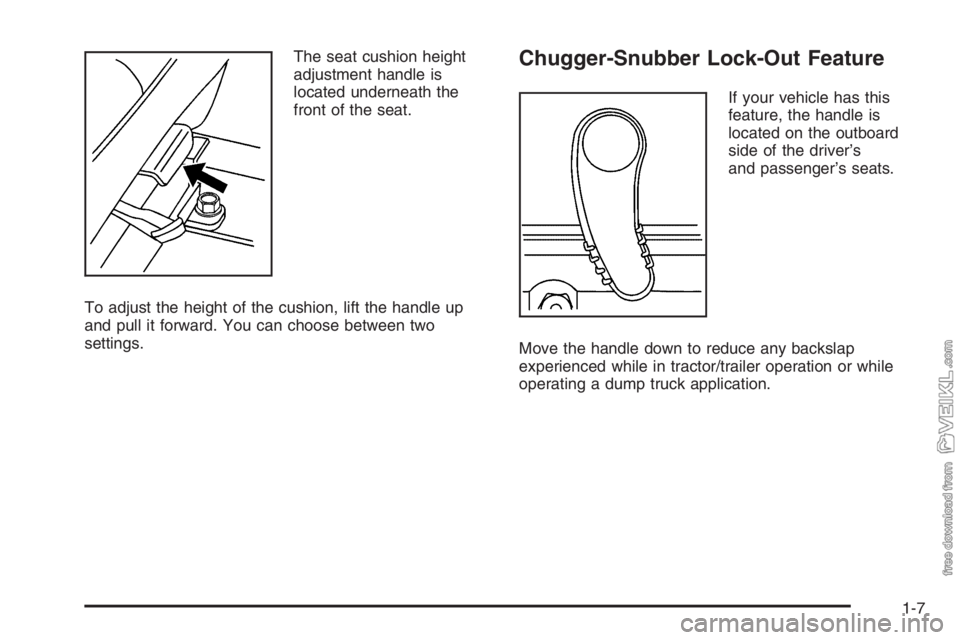
The seat cushion height
adjustment handle is
located underneath the
front of the seat.
To adjust the height of the cushion, lift the handle up
and pull it forward. You can choose between two
settings.Chugger-Snubber Lock-Out Feature
If your vehicle has this
feature, the handle is
located on the outboard
side of the driver’s
and passenger’s seats.
Move the handle down to reduce any backslap
experienced while in tractor/trailer operation or while
operating a dump truck application.
1-7
Page 14 of 398

Rear Seats
Rear Seat Operation
Folding the Rear Seat (Crew Cab)
{CAUTION:
A safety belt that is improperly routed, not
properly attached, or twisted will not provide
the protection needed in a crash. The person
wearing the belt could be seriously injured.
After raising the rear seatback, always check
to be sure that the safety belts are properly
routed and attached, and are not twisted.Notice:Folding a rear seat with the safety belts
still fastened may cause damage to the seat or the
safety belts. Always unbuckle the safety belts
and return them to their normal stowed position
before folding a rear seat.
The rear bench seat on the crew cab can be folded
down to provide more cargo space.
To fold down the seatback,
pull this nylon strap
located on the rear of the
seat, while pulling the
seatback down.
1-8
Page 15 of 398

To raise a seatback, pull the nylon strap while raising
the seatback until it locks upright.
{CAUTION:
If the seatback is not locked, it could move
forward in a sudden stop or crash. That could
cause injury to the person sitting there. Always
push and pull on the seatback to be sure it is
locked.
After raising a seatback to an upright position, push and
pull on the seatback to check that it is locked in place.
Safety Belts
Safety Belts: They Are for Everyone
This part of the manual tells you how to use safety
belts properly. It also tells you some things you should
not do with safety belts.
{CAUTION:
Do not let anyone ride where he or she cannot
wear a safety belt properly. If you are in a
crash and you are not wearing a safety belt,
your injuries can be much worse. You can hit
things inside the vehicle or be ejected from it.
You can be seriously injured or killed. In the
same crash, you might not be, if you are
buckled up. Always fasten your safety belt,
and check that your passengers’ belts are
fastened properly too.
1-9
Page 16 of 398
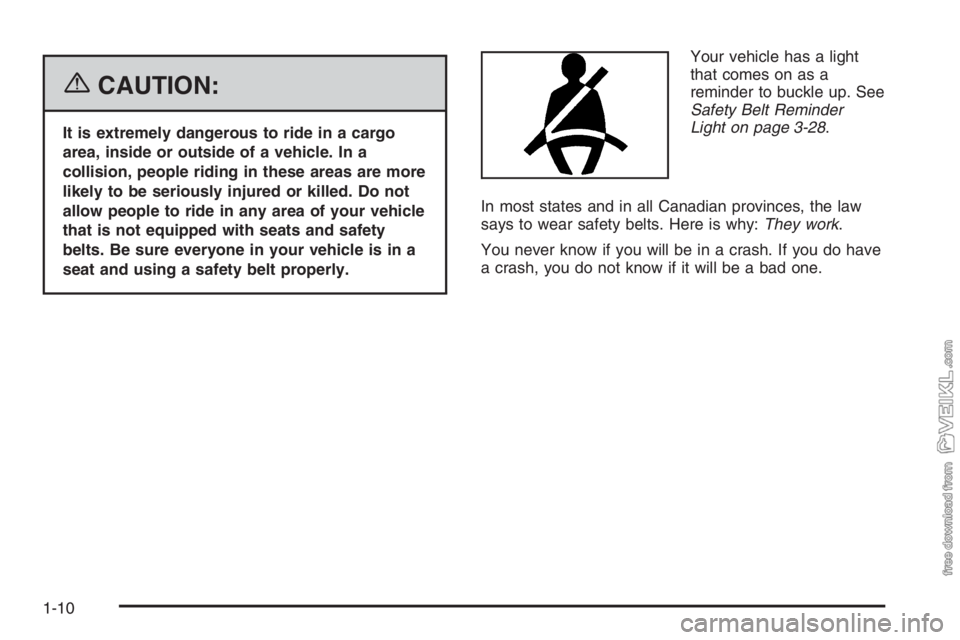
{CAUTION:
It is extremely dangerous to ride in a cargo
area, inside or outside of a vehicle. In a
collision, people riding in these areas are more
likely to be seriously injured or killed. Do not
allow people to ride in any area of your vehicle
that is not equipped with seats and safety
belts. Be sure everyone in your vehicle is in a
seat and using a safety belt properly.Your vehicle has a light
that comes on as a
reminder to buckle up. See
Safety Belt Reminder
Light on page 3-28.
In most states and in all Canadian provinces, the law
says to wear safety belts. Here is why:They work.
You never know if you will be in a crash. If you do have
a crash, you do not know if it will be a bad one.
1-10
Page 17 of 398
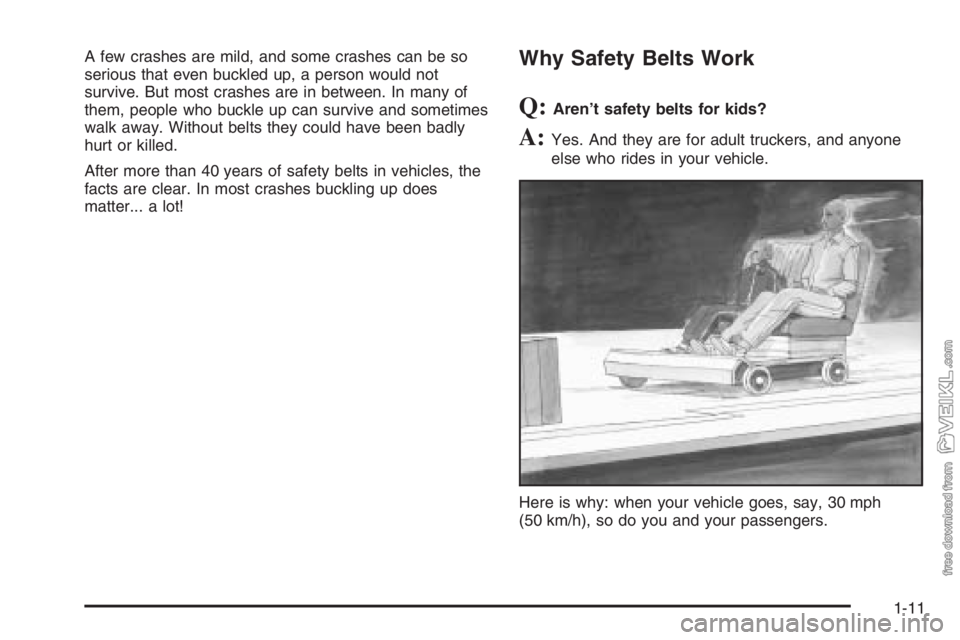
A few crashes are mild, and some crashes can be so
serious that even buckled up, a person would not
survive. But most crashes are in between. In many of
them, people who buckle up can survive and sometimes
walk away. Without belts they could have been badly
hurt or killed.
After more than 40 years of safety belts in vehicles, the
facts are clear. In most crashes buckling up does
matter... a lot!Why Safety Belts Work
Q:Aren’t safety belts for kids?
A:Yes. And they are for adult truckers, and anyone
else who rides in your vehicle.
Here is why: when your vehicle goes, say, 30 mph
(50 km/h), so do you and your passengers.
1-11
Page 18 of 398
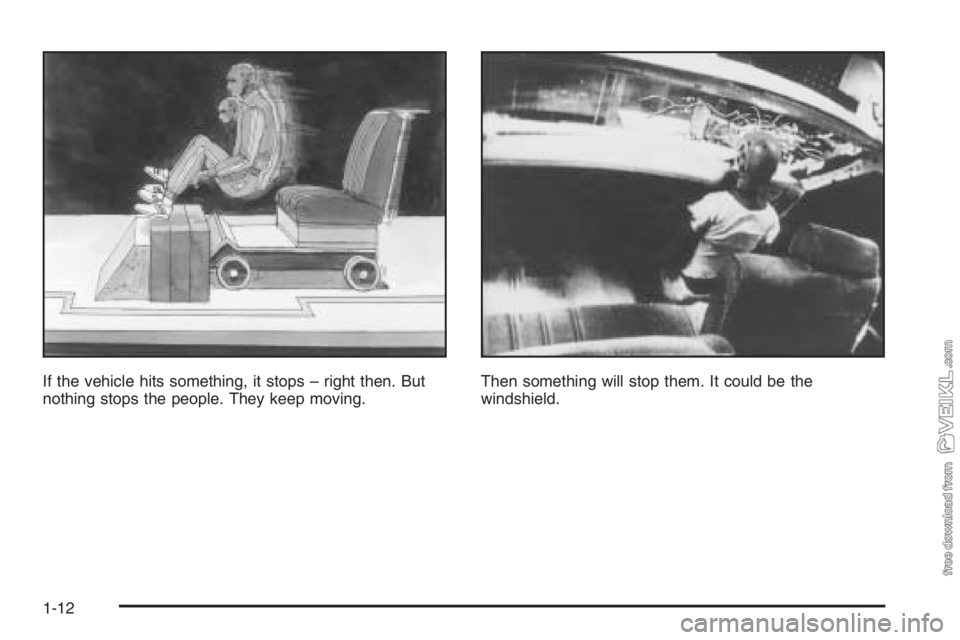
If the vehicle hits something, it stops – right then. But
nothing stops the people. They keep moving.Then something will stop them. It could be the
windshield.
1-12
Page 19 of 398
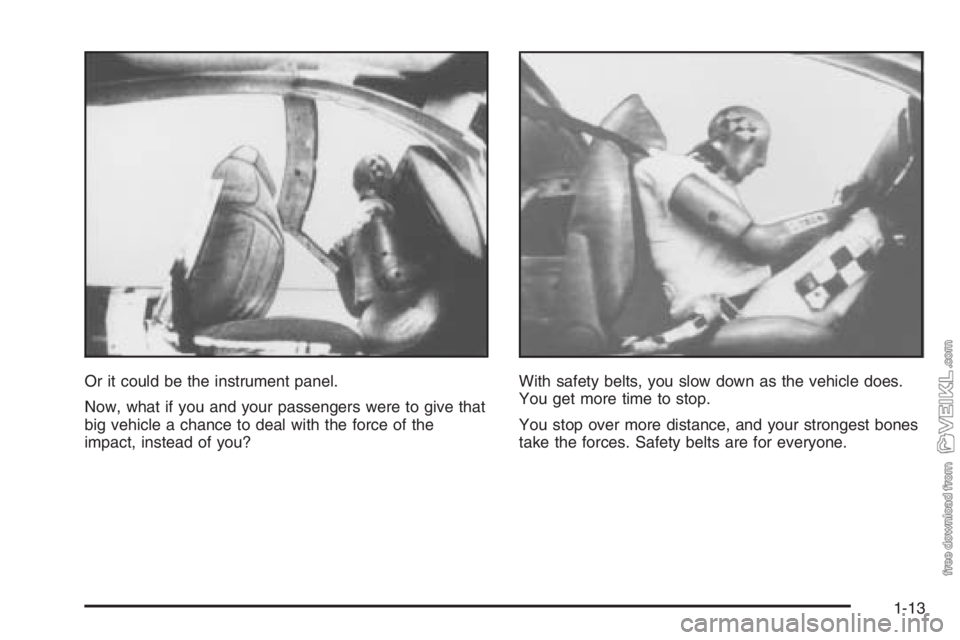
Or it could be the instrument panel.
Now, what if you and your passengers were to give that
big vehicle a chance to deal with the force of the
impact, instead of you?With safety belts, you slow down as the vehicle does.
You get more time to stop.
You stop over more distance, and your strongest bones
take the forces. Safety belts are for everyone.
1-13
Page 20 of 398
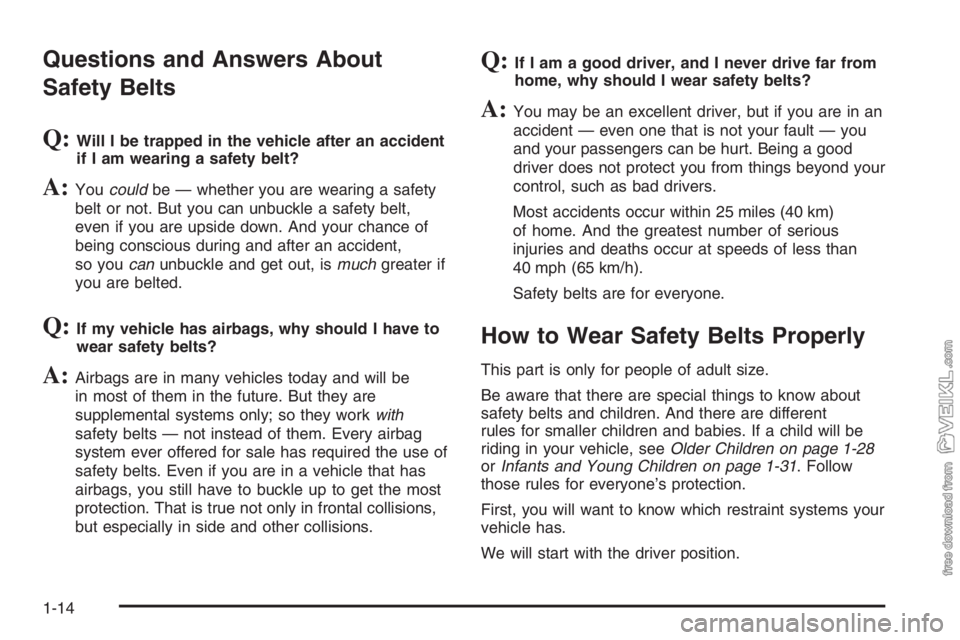
Questions and Answers About
Safety Belts
Q:Will I be trapped in the vehicle after an accident
if I am wearing a safety belt?
A:Youcouldbe — whether you are wearing a safety
belt or not. But you can unbuckle a safety belt,
even if you are upside down. And your chance of
being conscious during and after an accident,
so youcanunbuckle and get out, ismuchgreater if
you are belted.
Q:If my vehicle has airbags, why should I have to
wear safety belts?
A:Airbags are in many vehicles today and will be
in most of them in the future. But they are
supplemental systems only; so they workwith
safety belts — not instead of them. Every airbag
system ever offered for sale has required the use of
safety belts. Even if you are in a vehicle that has
airbags, you still have to buckle up to get the most
protection. That is true not only in frontal collisions,
but especially in side and other collisions.
Q:If I am a good driver, and I never drive far from
home, why should I wear safety belts?
A:You may be an excellent driver, but if you are in an
accident — even one that is not your fault — you
and your passengers can be hurt. Being a good
driver does not protect you from things beyond your
control, such as bad drivers.
Most accidents occur within 25 miles (40 km)
of home. And the greatest number of serious
injuries and deaths occur at speeds of less than
40 mph (65 km/h).
Safety belts are for everyone.
How to Wear Safety Belts Properly
This part is only for people of adult size.
Be aware that there are special things to know about
safety belts and children. And there are different
rules for smaller children and babies. If a child will be
riding in your vehicle, seeOlder Children on page 1-28
orInfants and Young Children on page 1-31. Follow
those rules for everyone’s protection.
First, you will want to know which restraint systems your
vehicle has.
We will start with the driver position.
1-14